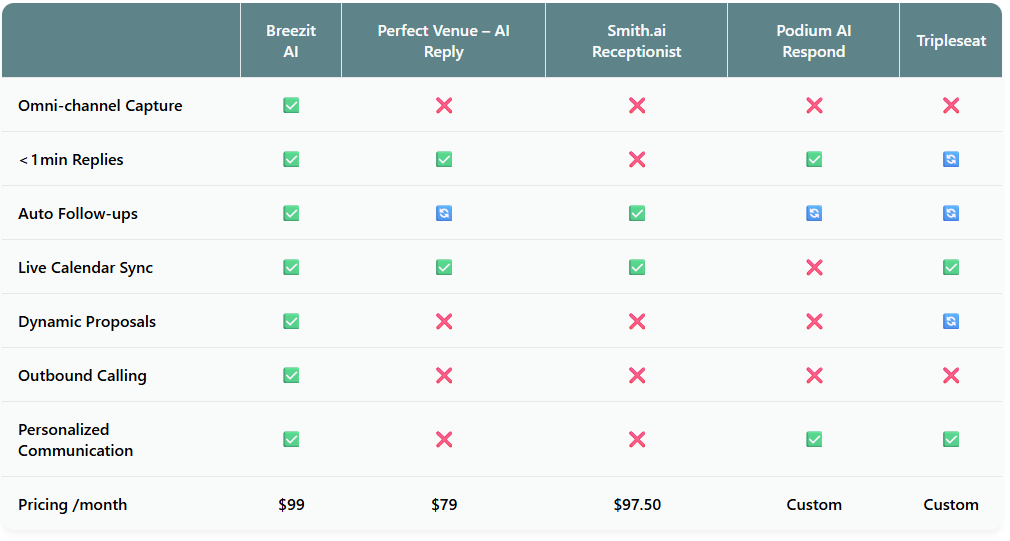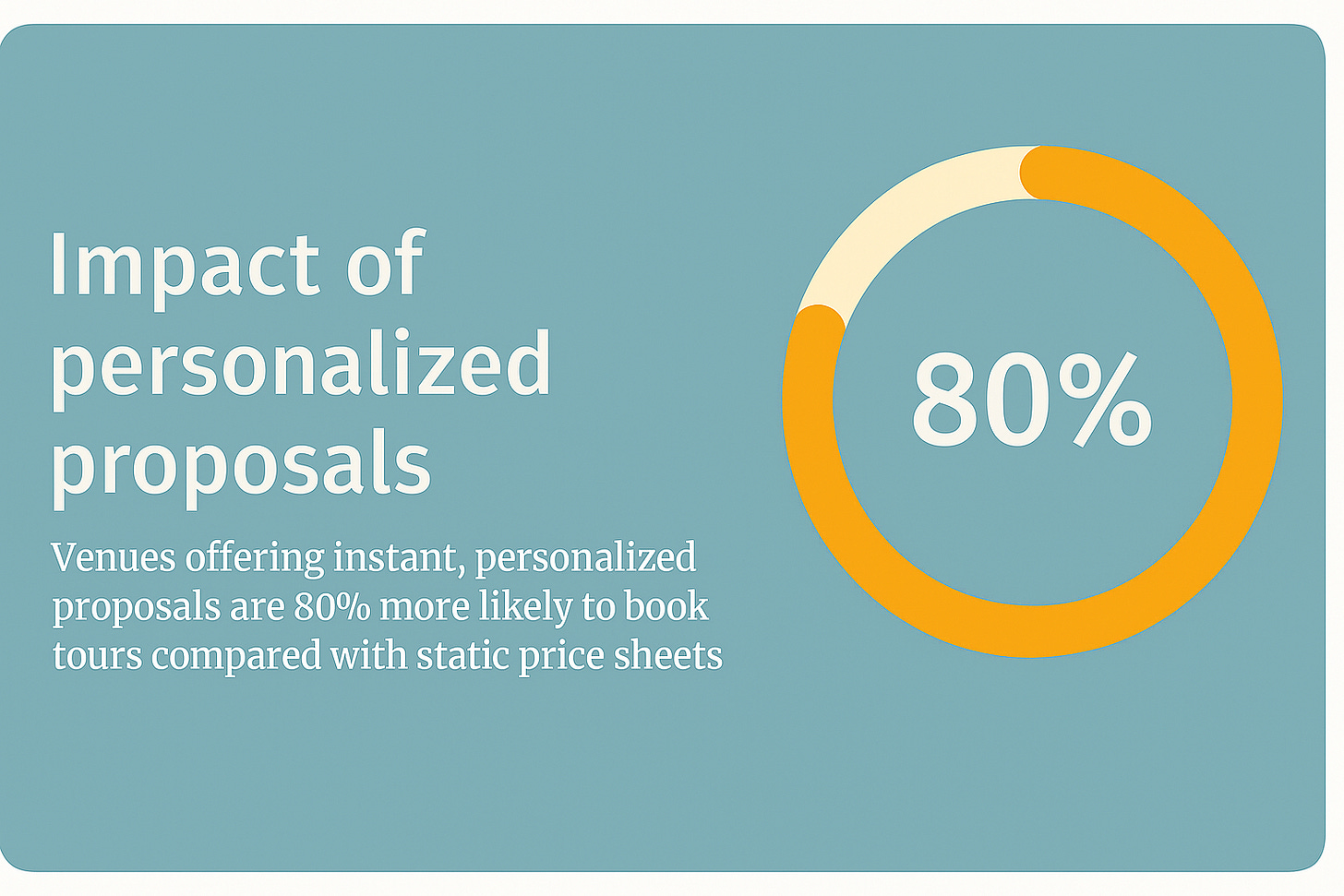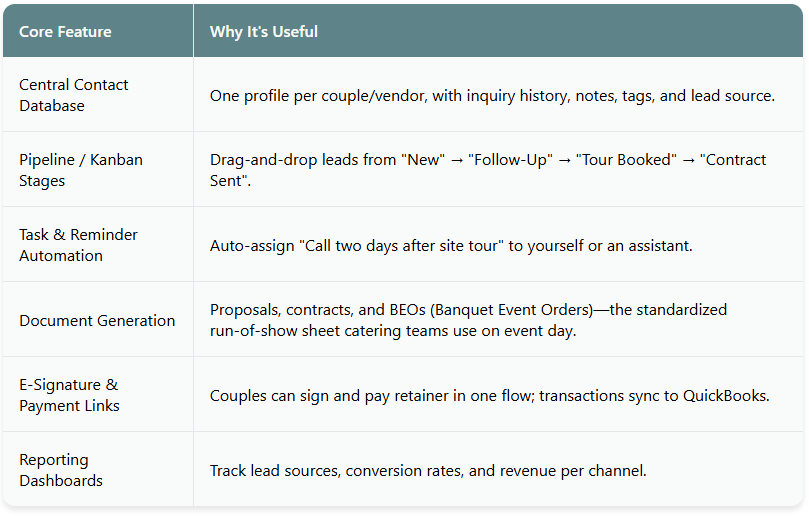Surviving the Lead Avalanche: A 2025 Playbook for High‑Volume Event Pros
The guide every 35‑to‑600‑inquiries‑per‑month venue, DJ, planner, caterer and other event pro needs in their bookmarks.
TL;DR & Road‑Map
Why “Too Many Leads” Is a Real Growth Ceiling
Fresh benchmarks on response‑time decay and the dollar value of each lost minuteAnatomy of an Inquiry Tsunami
The five repeat questions + the hidden labor cost of channel hopping2025 AI Tool-Comparison Matrix
See which five platforms event pros can’t live without
From Solo Hustle to Sales Team: What Each Strategy Really Costs (2025 Numbers)
DIY, VA, in‑house sales manager: volume thresholds, salary & ROI mathWhere AI Actually Fits
A 5-step workflow showing how AI takes admin off your plate while you stay the closerCRM Reality Check
Why contact databases don’t close deals on their ownJoin the Conversation
Share your main challenges with lead management, or sign up here to get notified when the first “Speed-to-Lead” webinar drops.
(Skim now, come back tonight when the inbox pings slow down.)
1 | Why “Too Many Leads” Becomes a Growth Ceiling
After 2,100+ sales calls with venues and vendors since 2023, I can tell you the biggest enemy of growth isn’t a weak marketing pipeline—it’s lag. In my latest California survey of 1,357 venue operators, monthly inquiry volume broke down like this:
38 % handle 35–50 inquiries
41 % juggle 50–250
21 % field 250–600+ during peak season
The physics of speed‑to‑lead are brutal:
Companies that answer within 5 minutes are 10× more likely to connect than at the 10‑minute mark.
Respond in the first hour and you’re 7× likelier to qualify the lead than if you wait just one more hour.
78 % of couples book the first vendor who replies.
Put bluntly: every unanswered ding on your phone is a potential $3 k‑to‑$10 k event walking into your competitor’s arms.
2 | Anatomy of an Inquiry Tsunami
The Channels
Website form
Instagram / TikTok DM
Email replies to that Reels promo you posted at 11 p.m.
Texts
Listing platforms: The Knot, WeddingWire, Zola, Breezit, Here Comes the Guide, etc.
Voicemails left after your site tours end at 7 p.m.
The Five Questions on Loop
“Is [date] still open?”
“Can we tour on [date]?”
“How much for X hrs / Y guests with bar package?”
“Will you travel to [location]—cost?”
“Pet‑friendly? Noise ordinance? Curfew?”
The Hidden Cost
Replying once is easy; replying three times across three channels to the same couple is where your day evaporates. Our audit of a 50‑leads‑per‑month barn venue showed staff spent 2-3 hrs/day in “switching” time—reading, re‑checking calendars, pasting pricing grids, doing follow ups—before a single tour was booked. Multiply that by peak season and you have a full‑time salary in pure context‑switching waste.
If reading this already makes your inbox itch, you’re not alone. The good news: 2025 brought a new wave of AI platforms built to tame this flood without hiring an extra headcount. Before we talk cost structures and workflows, here’s the short list most event pros are evaluating right now.
3 | 2025 AI Tool‑Comparison Matrix
Below is a snapshot of five platforms, what they actually cover, and where gaps still exist. Think of this as your co-pilot menu — the details on ROI and workflows come right after.
Legend: ✅ = native; 🔄 = partial/templated; ❌ = not offered.
(Think I missed a heavy‑hitter? Drop it in the comments.)
Tools listed: justbreezit.com, perfectvenue.com, smith.ai , podium.com, tripleseat.com.
👉 Want me to teardown one of these platforms in depth? Vote in the comments and I’ll line it up for a future issue.
4 | From Solo Hustle to Sales Team: What Each Strategy Really Costs (2025 Numbers)
With the tool landscape in mind, the next question is: does human help still make sense? Let’s run the numbers.
Quick math: At 250 inquiries a month, even a mid‑market VA ($22/hr × 80 hrs) costs $1,760/mo. If faster replies gain you just one extra $8 k event, the approach pays for itself 4.5× over—if your Standard Operating Procedures (SOPs) are airtight.
5 | Where AI Actually Fits—While You Stay the Closer
You’ve already seen the comparison grid — but remember: features and AI alone don’t close deals. Let’s zoom in on the five areas where AI delivers the most lift, and why pairing it with your closing skills matters.
What it can do is vaporize the repetitive admin that drains your will to sell: copy‑pasting availability, pasting pricing grids, chasing “Just checking in?” emails. When the paperwork and polite reminders are off your plate, you walk into every tour informed, and ready to close—because people still buy from people.
Here’s Where It Delivers the Most Lift
✔ Train AI on Your Knowledge
Upload pricing tiers, seasonal rate cards, house rules, preferred tone, and “do‑not‑quote” exceptions. The model now sings your brand voice—no robotic jargon—while staying inside guardrails you set.
Why it matters: Centralized FAQs and policies can drastically cut first‑reply drafting time.
✔ AI Handles Leads—Across Email, Calls, SMS & DMs
Whether a couple pings you on WeddingWire at 11 p.m. or calls at noon, AI triages, tags intent (“date check,” “quote,” “tour request”), and fires a branded response in under a minute. AI receptionists (e.g., Smith.ai, Posh) answer and transcribe calls; AI sales agents (Breezit AI) cover web, marketplaces, calls, live chat and text.
Why it matters: Respond within 5 minutes and you’re 50% more likely to connect with the lead than at the 10‑minute mark
✔ Generate Custom Proposals—Not One‑Size PDFs
The AI merges guest count, date, and selected add‑ons into a hyper‑personalized HTML or PDF proposal—complete with upsells, imagery, and e‑signature/payment links.
Why it matters: Venues offering instant, personalized proposals are 80% more likely to book tours compared with static price sheets.
✔ Automated Follow‑Ups That Never Forget
Drip sequences via email, SMS, or even AI‑placed voice calls ping prospects on day 1, 3, 7, 14. Cadence auto‑pauses when they reply or book a tour.
Why it matters: 80 % of sales require at least five follow‑ups, yet 44 % of reps stop after one. Automation fills that persistence gap.
✔ Check Availability & Reply On the Go
Two‑way sync with Google Calendar or Outlook means the AI verifies open dates before it promises them—whether the inquiry lands at 3 a.m. or while you’re leading a site tour.
Why it matters: When double bookings or calendar mix-ups happen, it’s not just a missed opportunity—it damages trust, pushes clients toward competitors, and can leave a lasting mark on your reputation.
✔ The Challenge—Until Now
Getting those five steps to talk to each other once required Zapier daisy-chains, pricey dev hours, a porcupine of APIs — and the deep technical know-how most event pros don’t have time to master. As a result, most teams stayed stuck in copy‑paste purgatory. Good news: 2024‑25 ushered in a new wave of AI platforms with friendly price points (from $99/mo) and out‑of‑the‑box integrations—no code, no headaches. The comparison matrix in Section 3 shows five of the most mature options and the gaps each one still leaves for you to fill.
Why bother?
Pros who reply inside 5 minutes are 10× more likely to connect with a lead than those that wait 10 minutes
80 % of bookings need ≥ 5 follow‑ups, yet 44 % of salespeople quit after the first
In short, the boring bits you’d rather skip are precisely the bits AI excels at.
6 | CRM Reality Check — What It Does and What It Doesn’t Do
What a Modern Event CRM Actually Covers:
Where CRMs Still Fall Short
Omni‑Channel Replies – Most CRMs monitor email only. Instagram DMs, Zola inbox messages, and texts remain siloed unless you bolt on extra integrations or Zapier zaps.
Real‑Time Date Checks – Very few CRMs talk directly to Google Cal or Outlook in real time. That means you (or staff) still open the calendar tab before confirming availability.
Dynamic Pricing Engines – Packages change with guest count, season, and add‑ons. CRMs usually store static price lists, so complex quotes still become midnight copy‑paste jobs.
Drip Follow‑Ups Across Channels – You can schedule an email sequence, yes, but most systems won’t natively send the Day‑3 SMS nudge or place the Day‑14 courtesy call.
AI‑Driven Personalization – Generating a bespoke proposal that references the couple’s theme, menu preferences, and travel distance still requires human edits unless you overlay an AI assistant.
The Net-Net
Toolbox ≠ finished house.
A CRM is like owning a full set of power tools—great, but they don’t build the house for you. To turn stored data into bookings, you still need two things:
Clear SOPs (Standard Operating Procedures) – a written playbook that tells anyone (or any AI) exactly when to reply, what to quote, and when to escalate.
Hands on the controls—human or AI – someone (or something) following those SOPs in real time.
Without both, you’ll be back to manually pasting last year’s pricing table into an email at midnight.
Quick Audit Example for Venues & Event Pros
(Time-box 20 minutes this afternoon to audit your CRM, following this example.)
7 | Join the Conversation
🛠️ Already tried one of the tools from the AI Tool Matrix? Share your experience below — your input might shape the next teardown.
🚀 Want first dibs on the live “Speed‑to‑Lead” demo?
Click here to get notified when registration opens—subscribers get 48‑hour early access, plus a bonus audit template.
Until next time, keep those reply times under five minutes and those deposit invoices stacking high. 🥂
—Future Booked







